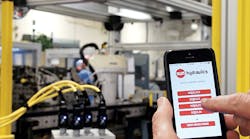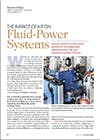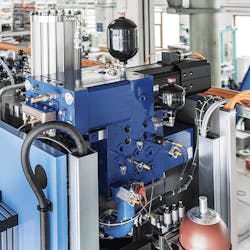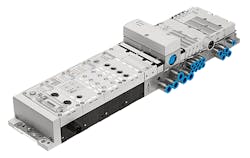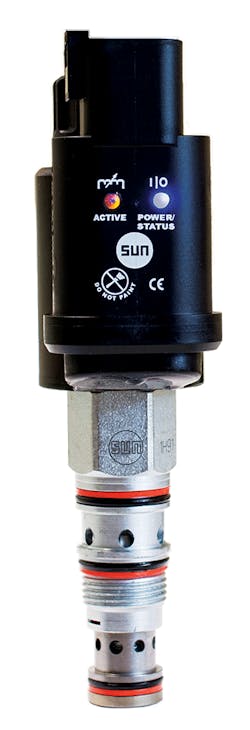This file type includes high-resolution graphics and schematics when applicable.
When we talk about the Internet of Things (IoT), we usually discuss electrical technology. Obviously, IoT is powered by computers, Ethernet, and wireless devices, but it is also reaching out and updating different fields of industry. For instance, IoT’s influence is being felt within the realm of fluid-power systems (i.e., hydraulic and pneumatic systems). We spoke to three experts in this field to give their take on how IoT is affecting the fluid industry:
• Dr. Steffen Haack, Bosch Rexroth, Member of the Executive Board responsible for the Business Unit Industrial Applications and Coordination Sales
• Frank Langro, Festo Corp., Director - Marketing/Product Management
• Gary Gotting, Sun Hydraulics, Marketing
How are hydraulic or pneumatic devices (pumps, actuators, pipes, valves, etc.) being modernized for the Internet of Things (i.e. sensors, Ethernet connections, etc.)? What are the current technology trends?
Haack: Hydraulics and electronics have belonged together for decades. We are currently seeing a strong trend toward the broad digitalization of the hydraulic product portfolio. We have systematically expanded our portfolio of electrohydraulics components and modules with digital interfaces and sensor intelligence. The products have a decentral intelligence and exchange data via multi-Ethernet interfaces with other devices like controls. Standardized, integrated digital electronics offers a wide range of functionality driven by software applications. Modern hydraulics is as intelligent and has the ability to be as connected as electronic products or electromechanical actuators.
Gotting: Promoting and embedding low-power Bluetooth connectivity for remote valve-controller configuration is a crucial update for products without a direct line of sight. Safety is the driving factor here, seconded by ease of use, with a common cell phone now being the entire service tool needed. A valve can be installed where it needs to be for optimized operation instead of for accessibility.
What are the current technology trends?
Haack: Hydraulic components are adapting more and more to electronics for intelligent motion as well as to sensors for gathering operating data values online. Analysis of this data is the key concept for condition monitoring, predictive maintenance, and machine-to-machine communication.
Langro: Sensor technology and Ethernet connectivity is definitely leading the way for implementation of “Smart Manufacturing” and “Industry 4.0.” Both are current methods of implementing IoT systems and its key enablers.
Gotting: Current technology trends driving development include smaller valve envelopes with embedded controllers that are matched to mechanical parts and nulling tolerances. Lower electrical power and higher electrical efficiency for standard, hybrid, and electrical vehicle systems are also creating need. We are working to lower battery demand, standby/idle drain, battery, and connector size, and reduce harness AWG requirements for current capacity and weight.
What are the benefits of using hydraulics or pneumatics over electromechanical drives, considering that many electromechanical drives can be easily connected to IoT equipment (i.e., PLCs, Ethernet hubs)?
Haack: Hydraulic controls and drives have some unique physical properties, such as higher power density or robustness against overload and shocks. In combination with digital electronics, modern hydraulics offer the best out of two worlds: The advantages of the fluid technology together with the flexibility of modern controls architecture. For superior controls, it does not matter if an actuator is electromechanical or electric or electro-hydraulics, as long as both have their own decentral intelligence with software functionality and open standardized interfaces for communication.
Langro: Application is what should really drive the selection of pneumatic, electromechanical, or hybrid solutions. Aspects such as force requirements, precision, and speed are most important. Today, with intelligent valve terminals, things such as Ethernet connectivity and sensor technology are now possible with pneumatic solutions and not only electromechanical solutions. A great example of this would be the Festo CPX-MPA-based valve terminal system. This was the first pneumatic valve manifold to incorporate serial communication on the pneumatic valve side, which enabled sensor technology to be incorporated very easily, whereas before with parallel communication it was practically impossible. Once you have a pressure or flow sensor present and feeding information to the control, you now have intelligence to create more efficient or adaptive systems.
Gotting: Fluid-power drives can be compact, with no gearboxes needed to increase torque or speed. Trace fluids can be a visual cue to a field-service person for impending issues. Hydraulic solutions can offer substantially more power relative to total weight than electric motors.
What is the role of software in current IoT fluid-power systems?
Haack: There is a massive shift of functionality in the software architecture of drive technologies. The challenge is to standardize across different technology interfaces, communication protocols, and engineering tools such as electromechanical and electro-hydraulics drives. This applies for all drives, controls, and the sensor landscape. The same electronic hardware is used in both drives and controls. Along with wizard engineering tools and control algorithms for hydraulic actuators, commissioning engineers and operators do not need an in depth knowledge of hydraulics. The software wizards lead them through the process and suggest parameters that are adequate for a first commission and fast startup in most applications.
Gotting: Embedded software is now commonplace for individual valve control, giving OEMs a good way of protecting their IP. Optimizing the product at this base level allows the system builder to utilize a stable, known building block to achieve correct operation.
Langro: To standardize across different technology interfaces, Ethernet connectivity is important, but standardizing the communication protocol will be instrumental in making Industrial IoT a reality. Open Platform Communications Unified Architecture (OPC-UA) enables data exchange from products by different manufacturers and between different operating systems.
Haack: Current software is offering different levels of analytics, from decentral to cloud-based big-data approaches, helping our customers to significantly increase the performance and availability of their equipment. That leads to an increase in efficiency, easy diagnostics, and energy savings, which all leads to direct cost savings.
Gotting: We see mobile applications as a now accepted way of sharing tools, updates, and information with our users. Software is also important when complex functions are reduced to point-of-use products. As an example, High Country Tek’s EVC is capable of multiple functions, allowing the end user to easily incorporate complex functions without needing to be a programming expert. Software offers customers more product flexibility, increased capabilities, system repeatability, and more operational options at much lower cost.
What are the disadvantages of using fluid power for IoT systems?
Haack: Technology-wise there are no disadvantages, as long as the hydraulic system uses well-known and established standards and interfaces. IoT does not care for the drive technology itself; rather, it stands for seamless horizontal and vertical integration with continuous exchange of data.
Gotting: To properly accept signals and transmit details of controller operation, health, temperature, and other values, the fluid-power system requires an embedded digital controller. If valve position, pressure, or another parameter is critical, the relative sensor needs to also be connected to the controller so that it can share information through the bus.
Does the nonlinearity of fluid-power systems cause a problem with sensor and data feedback for connected systems?
Langro: There should be no problem with sensor and data feedback. This is where software can compensate and is typically used to model feedback accordingly.
Haack: Definitely not. Analog and digital electronic components have long been integrated into hydraulic products. Electronic interconnectivity is a basic requirement for the interaction between hydraulic and electric components in modern hydraulic systems. In this context, the nonlinearity of hydraulics is deeply considered in the engineering process for all kind of hydraulic components, such as valves, pumps, cylinders, and sensors. The electric controllers themselves (whether located on board or externally) contain intelligent algorithms and allow the interpretation and translation of the different hydraulic sensor signals.
The software of intelligent and interconnected hydraulic products compensate the nonlinearities of fluid technologies. We have developed and integrated algorithms based on our extensive application experience into the drive electronics, ranging from cabinet-free single-axis controllers to complex motion-logic controls for a large number of axes. This allows hydraulic systems to work exactly like electric or electromechanical drives.
Gotting: Sensors are more readily available now and provide information from more than one element. They are used for diagnostics, prognostics, and for measuring several parameters. The measurements in turn can be used to correct a valve’s operation to reduce or null nonlinearity effectively. Some sensors are now Bluetooth-compatible, which aligns with Sun’s use of this protocol in valve configuration, using the same cell-phone tool for all machine overview actions.
What new technology is coming out to help integrate IoT into fluid-power systems?
Gotting: Hydraulics has come a long way in just the past 10 years. The rise of technology has pushed the industry toward ease of use, intelligent design, configurability, and precision control. Entire machines can be monitored, configured, and maintained from a single display interface. The only means of developing such a system is through intelligent communication networks exchanging data in real time. Combine this intelligence with the vast capabilities we have become so accustomed to: texting, downloading smartphone apps, or connecting to wireless speakers via Bluetooth.
Developing human machine interfaces using technologies that the average person is comfortable with makes system design intuitive and more easily manageable. Machines can send update messages via text or contact specific service people when systems fail. Utilizing Bluetooth technology offers the first-ever wireless and configurable hydraulic-flow-control device. Calibration of valves, which were once dangerous or difficult to reach, can now be done from a safe distance. Even if the job does not require added safety, wireless connections like Bluetooth offer an easy, quick, and intuitive way to calibrate valves, making training and troubleshooting a breeze. The added cost of additional communication harnesses or costly software disappears with the average person equipped with an iPhone or Android.
The industry will continue to see products that utilize common technology in order to increase efficiency, make complex functions intuitive, and reduce wiring and install costs, ultimately adding value to the end user. Sensor technology is expanding what information we can measure and digitally share, making interfaces easier with less conversions and losses.
Looking for parts? Go to SourceESB.
